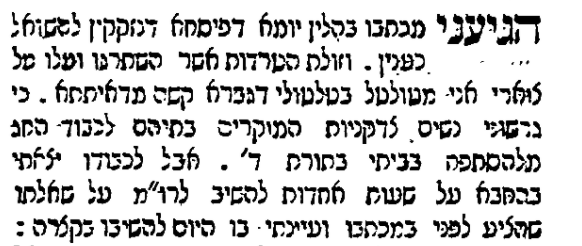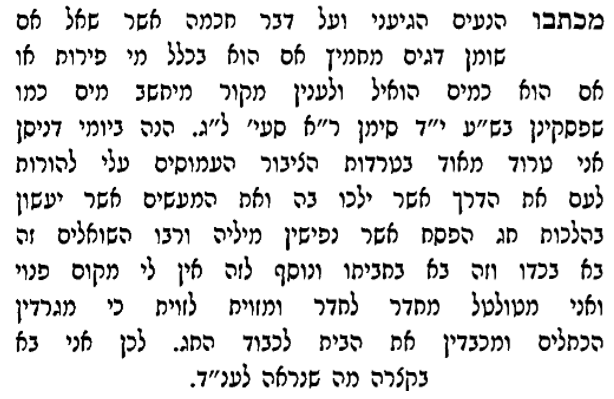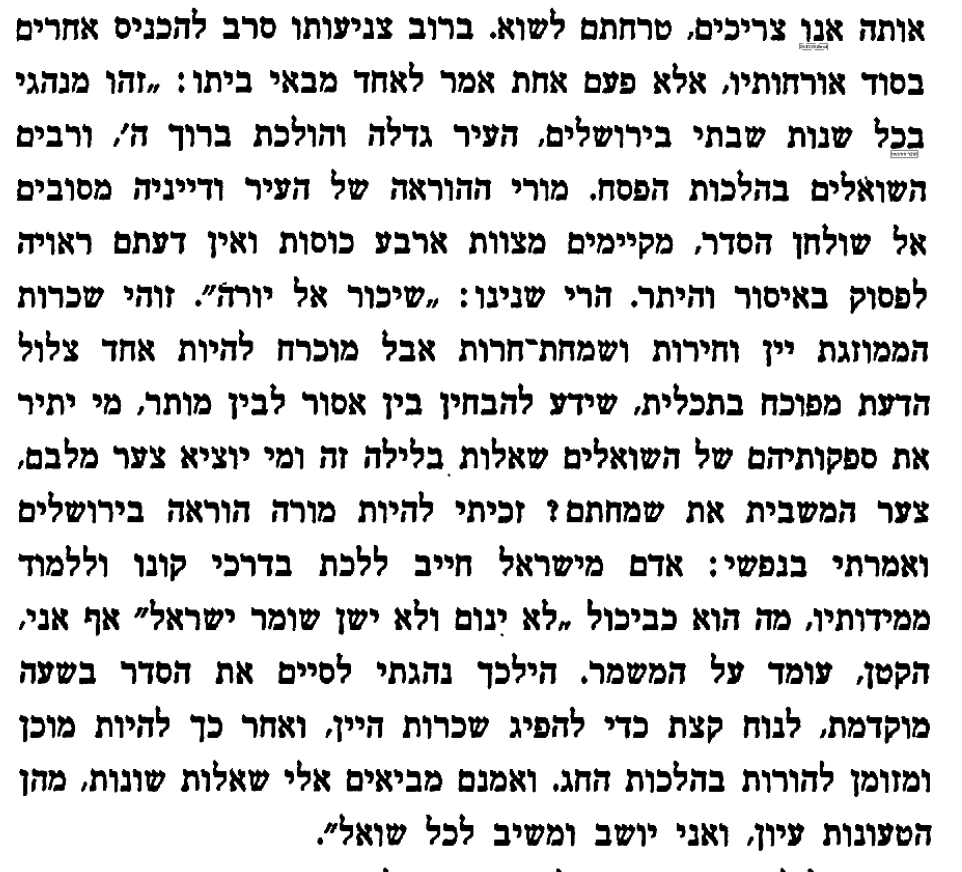On this page of Talmud we read of a very bizarre case:
יבמות נד, א
אָמַר רַבָּה: נָפַל מִן הַגָּג וְנִתְקַע — חַיָּיב בְּאַרְבָּעָה דְּבָרִים, וּבִיבִמְתּוֹ לֹא קָנָה. בְּנֵזֶק, בְּצַעַר, בְּשֶׁבֶת, בְּרִפּוּי. אֲבָל בּוֹשֶׁת לָא מִיחַיַּיב, דְּאָמַר מָר: אֵין חַיָּיב עַל הַבּוֹשֶׁת עַד שֶׁיִּתְכַּוֵּון
Rabba said: One who fell from a roof and was inserted into a woman due to the force of his fall is liable to pay four of the five types of indemnity that must be paid by one who damaged another, and if she is his yevama he has not acquired her in this manner. He is liable to pay for injury, pain, loss of livelihood, and medical costs. However, he is not liable to pay for the shame he caused her, as the Master said: One is not liable to pay for shame unless he intends to humiliate his victim…
As weird Talmudic cases go, this is among the weirdest. It is entirely impossible, and not least because this would happen. Did the rabbis of the Talmud really believe that such a case could occur? To answer this, let’s consider come other rather implausible cases from across the Babylonian Talmud.
The AMAZING Shechita Knife
We begin with a fanciful question that is somewhat analogous to tomorrow’s falling Yibbum case. What happens if a person throws a knife across the room, but in doing so the flying knife somehow manages to cut the neck of an animal in just the correct fashion to perform a kosher shechita (ritual slaughter). Is the meat of this slaughtered animal kosher?
חולין לא, א
דתני אושעיא זעירא דמן חבריא זרק סכין לנועצה בכותל והלכה ושחטה כדרכה ר' נתן מכשיר וחכמים פוסלים הוא תני לה והוא אמר לה הלכה כר' נתן
Oshaya, the youngest of the company of Sages, taught a baraita: If one threw a knife to embed it in the wall and in the course of its flight the knife went and slaughtered an animal in its proper manner, Rabbi Natan deems the slaughter valid and the Rabbis deem the slaughter not valid. Oshaya teaches the baraita and he says about it: The halakha is in accordance with the opinion of Rabbi Natan that there is no need for intent to perform a valid act of slaughter.
The Fish That Pulled a Plough
The Bible (Deuteronomy 22:10) forbids a farmer to plough his land using an ox and a donkey together. While no reason for this law is given, we might suppose it has something to do with the concern that doing so might cause unnecessary pain to the smaller (or perhaps the larger?) animal. Regardless of the reason, the Talmud explains that this law applies to any kind of work and any two different species of animal. Then comes this fantastic question: “What is the law if someone pulls his wagon using a goat and a fish?”
בבא קמא נה, א
בעי רחבה המנהיג בעיזא ושיבוטא מהו מי אמרינן כיון דעיזא לא נחית בים ושיבוטא לא סליק ליבשה לא כלום עביד או דלמא השתא מיהת קא מנהיג
The Sage Rachava raised a dilemma: With regard to one who drives a wagon on the seashore with a goat and a shibbuta, a certain species of fish, together, pulled by the goat on land and the fish at sea, what is the halakha? Has he violated the prohibition against performing labor with diverse kinds, in the same way that one does when plowing with an ox and a donkey together, or not?
This turned out to be such a hard question that the Talmud could not answer it. The Rosh concludes though that just to be sure, best not to hitch up your wagon to a fish, if you also intend for it to be pulled by a goat (ולא איפשיטא ואזלינן לחומרא). Don’t say you weren’t warned.
The Bird that built her nest on a person’s head
The Bible also demands that the mother bird must be shooed away before collecting the eggs upon which she is brooding. But what happens if a bird makes her nest in a person’s hair? Must this mother be driven away before her eggs are collected? (Chullin 139b)
חולין קלט, ב
אמרי ליה פפונאי לרב מתנה מצא קן בראשו של אדם מהו? אמר (שמואל ב טו, לב) ואדמה על ראשו
The residents of Pappunya said to Rav Mattana: If one found a nest on the head of a person, what is the halakha with regard to the mitzva of sending away the mother? Is the nest considered to be on the ground, such that one is obligated in the mitzva? Rav Mattana said to them that one is obligated in the mitzva in such a case because the verse states: “And earth upon his head” (II Samuel 15:32), rather than: Dirt upon his head, indicating that one’s head is considered like the ground.
(And just to be clear - the Talmud is not discussing a case like this one, in which a woman allowed an abandoned fledgling to nest in her long har for 84 days, though it is, I will admit, a very touching story.)
One hypothetical too many
Sometimes, even bizarre questions can go too far. If a baby pigeon is found within 50 cubits of a coop, it is presumed to belong to the owner of that coop. If it is found further away than 50 cubits, it belongs to the finder. Ever keen to push the limits of rabbinic law, Rabbi Yirmiyah asked “if one foot of the pigeon is within the fifty cubits and one foot is outside, to whom does it belong?” This apparently was one question too many. The rabbis (rather unfairly in my opinion) expelled Rabbi Yirmiyah from the Yeshivah for asking it.
בבא בתרא כג, ב
בָּעֵי רַבִּי יִרְמְיָה רַגְלוֹ אַחַת בְּתוֹךְ חֲמִשִּׁים אַמָּה וְרַגְלוֹ אַחַת חוּץ מֵחֲמִשִּׁים אַמָּה מַהוּ וְעַל דָּא אַפְּקוּהוּ לְרַבִּי יִרְמְיָה מִבֵּי מִדְרְשָׁא
Rabbi Yirmeya raises a dilemma: If one leg of the chick was within fifty cubits of the dovecote, and one legwas beyond fifty cubits, what is the halakha? The Gemara comments: And it was for his question about this far-fetched scenario that they removed Rabbi Yirmeya from the study hall, as he was apparently wasting the Sages’ time.
The Role of Bizarre cases
In a 2004 paper published in Thalia: Studies in Literary Humor, Hershey Friedman, a Professor of Business at Brooklyn College, suggested that “whether a situation is possible or not is immaterial when the Talmud is trying to establish legal principles.”
Purely theoretical (at least in their days) cases are discussed because the sages felt that principles derived from these discussions would clarify the law and thus provide a more thorough understanding of it. Discussions of theoretical cases in the Talmud have allowed scholars of today to use the Talmudic logic and principles to solve current legal questions
The theoretical questions make a legal point, and it is that legal point that is the real object of the discussion. Whether or not the case could actually happen is immaterial. Friedman also suggests that these unusual cases serve to keep the material interesting, and also act as brain teasers, which don’t necessarily make a legal point but serve to sharpen the minds of both the students and the teachers who ask them.
“There was a time, not many years ago, when a lawyer could feel reasonably confident as he approached oral argument in the United States
Supreme Court if he had thoroughly absorbed the record in his case and
had obtained a working knowledge of all relevant cases. No longer. Today, an advocate must, more than ever before, prepare himself for a
stream of hypothetical questions touching not only on his own case but on
a variety of unrelated facts and situations.”
Hypothetical Cases in the US Legal System
It may help to understand the role that these weird cases have in the Talmud by understanding that hypothetical cases have an important role to play in many legal systems, including that of the United States. Consider this series of questions that were asked in the famous 1984 case of California vs Carney. Police officers entered a motor home without a search warrant, and found marijuana. The question before the court was whether this motor home was a more like a car, which should not require a search warrant, or more like a home, which would. There were various appeals, and the case ended up being heard in front of the US Supreme Court, which is where the following hypothetical questions were raised:
Q: Well, what if the vehicle is in one of these mobile home parks and hooked up to water and electricity but still has its wheels on?
Q: Suppose somebody drives a great big stretch Cadillac down and puts it in a parking lot, and pulls all the curtains around it, including the one over the windshield and around all the rest of them. Would that be a home?
Or how about this exchange back in 1982, (and the subject of which is once again a hot topic of debate in the US). In Board of Education v.Pico, the question before the Court was whether a public school board could remove books which it found to be objectionable from the shelves of junior and senior high school libraries, in order to promote the community's "moral, social, and political values."
Q: Suppose they [the Board] barred the St. James version of the New Testament, and the Constitution of the United States, and the Declaration of Independence?
Q: Suppose some of these books were assigned as outside reading, and the children were told, you can get it in the public library?
Q. Suppose you had a book, counsel, that had been the subject of criminal proceedings, and conviction of someone in connection with that book had been sustained, a criminal conviction. Would you say that the book comes under this broad authority you suggest?
(By the way, the Court, in a 5-to-4 decision, held that as centers for voluntary inquiry and the dissemination of information and ideas, school libraries enjoy a special affinity with the rights of free speech and press. Therefore, the School Board could not restrict the availability of books in its libraries simply because its members disagreed with their content. That might be useful to remember.)
There are many, many similar examples. Here is one of my favorites. It comes from United States v. Ross, in which the defendant’s lawyer argued that a small brown paper bag should not have been searched for narcotics because it was protected under the Fourth Ammendment, the right against unlawful search. Here is one of the hypotheticals:
Q: Suppose what they were hunting for was, say, a waffle iron, a stolen waffle iron, or something else that couldn't go in the paper bag. You might have probable cause to search the car for the waffle iron, but if you got to the paper bag, you wouldn't be searching it, would you?
Commenting on this case, the late American lawyer Elijah Barrett Prettyman Jr. (d. 2016) wrote that “one cannot help but be impressed with how far removed some hypotheticals are from the facts before the Court. In Ross, the brown paper bag case, one Justice had the police hunting for a waffle iron.”
Why we need Hypotheticals
Hypothetical cases are really important when the Supreme Court is trying to figure out the difficult cases that come before it. And they are all difficult cases, because if they were easy, the Supreme Court wouldn’t be considering them. The rabbis of the Talmud needed to do the same, which is why they often consider outlandish, implausible or downright fanciful cases to ponder.
The best way to think about these cases is to add in the following missing words: “Hypothetically, what would happen if…” Then, as if by magic, they cease to be silly and start to be really important.


















